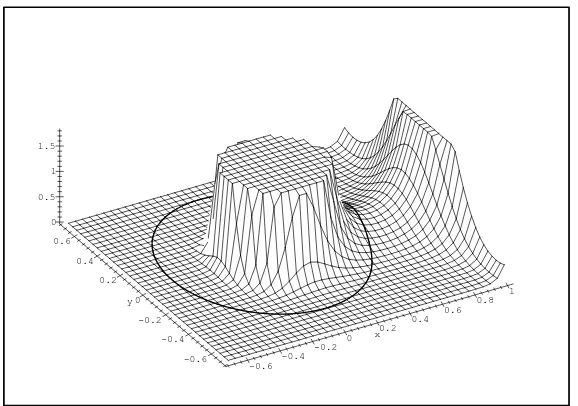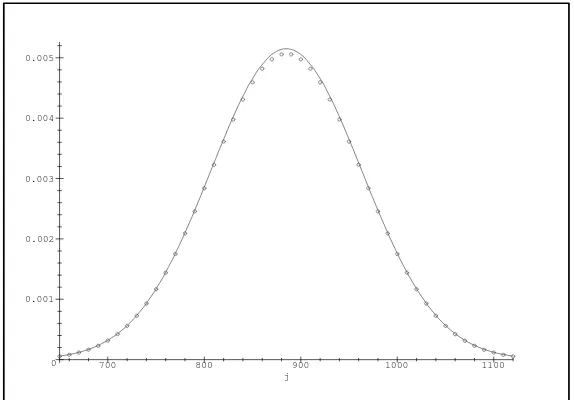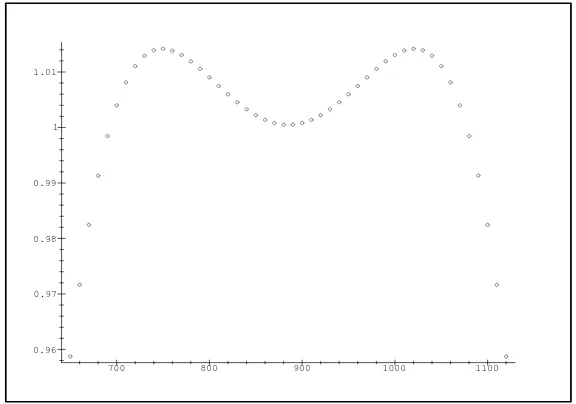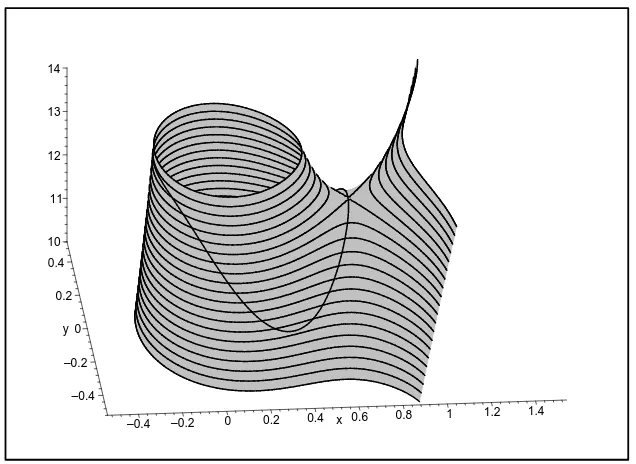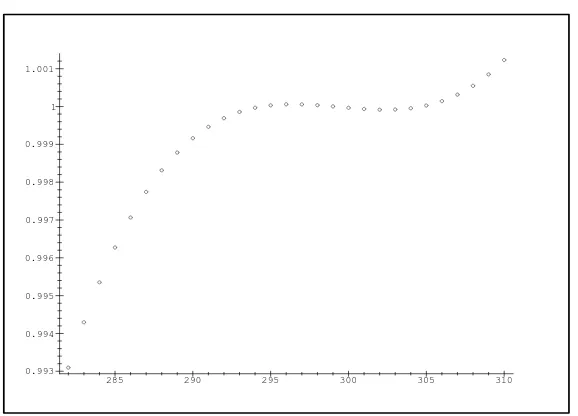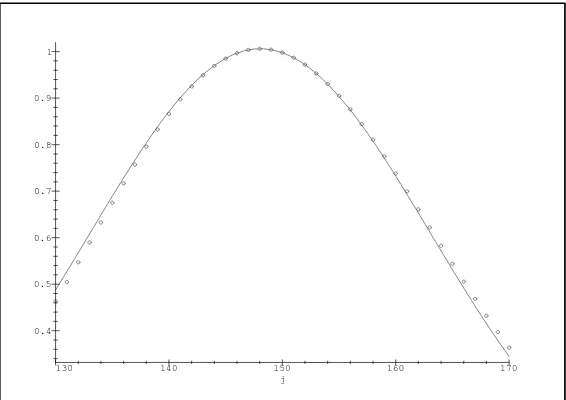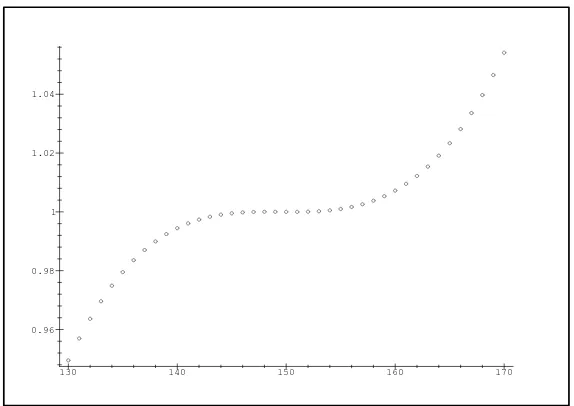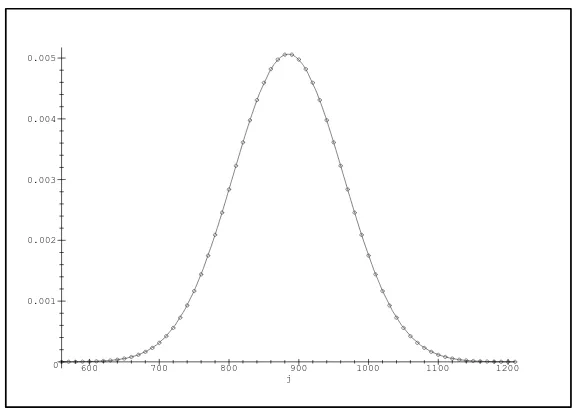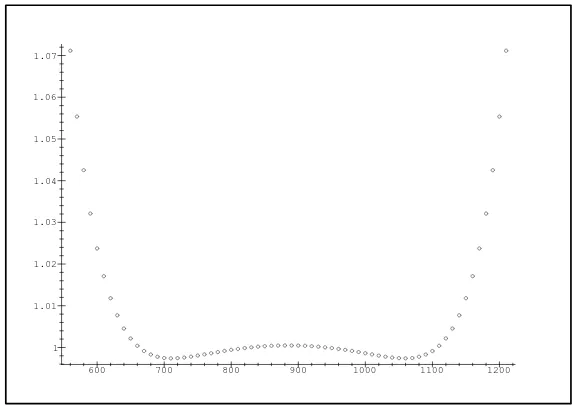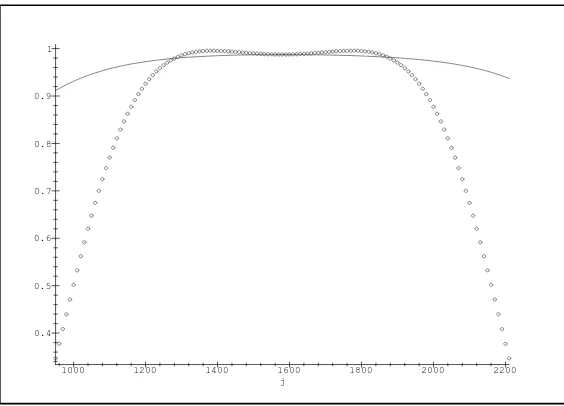23 11
Article 03.2.8
Journal of Integer Sequences, Vol. 6 (2003), 2
3 6 1 47
The Number of Inversions in Permutations:
A Saddle Point Approach
Guy Louchard
D´
epartement d’Informatique
CP 212, Boulevard du Triomphe
B-1050 Bruxelles
Belgium
Helmut Prodinger
University of the Witwatersrand
The John Knopfmacher Centre for Applicable Analysis and Number Theory
School of Mathematics
P. O. Wits
2050 Johannesburg
South Africa
Abstract
Using the saddle point method, we obtain from the generating function of the inversion numbers of permutations and Cauchy’s integral formula asymptotic results in central and noncentral regions.
1
Introduction
Let a1· · ·an be a permutation of the set {1, . . . , n}. If ai > ak and i < k, the pair (ai, ak)
is called an inversion; In(j) is the number of permutations of length n with j inversions.
In a recent paper [7], several facts about these numbers are nicely reviewed, and—as new results—asymptotic formulæ for the numbers In+k(n) for fixed k and n → ∞ are derived.
This is done using Euler’s pentagonal theorem, which leads to a handy explicit formula for
-0.6 -0.4 -0.2 0 0.2 0.4 0.6 0.8 1 x -0.6 -0.4 -0.2 0 0.2 0.4 0.6 y 0 0.5 1 1.5
Figure 1: |Φ10(z)/z11| and the path of integration
Here, we show how to extend these results using the saddle point method. This leads, e. g., to asymptotics forIαn+β(γn+δ), for integer constantsα,β,γ,δ and more general ones
as well. With this technique, we will also show the known result thatIn(j) is asymptotically
normal.
The generating function for the numbersIn(j) is given by
Φn(z) =
X
j≥0
In(j)zj = (1−z)−n n
Y
i=1
(1−zi).
By Cauchy’s theorem,
In(j) =
1 2πi
Z
C
Φn(z)
dz zj+1,
whereC is, say, a circle around the origin passing (approximately) through the saddle point. In Figure 1, the saddle point (near z = 1
2) is shown for n =j = 10.
As general references for the application of the saddle point method in enumeration we cite [4,8].
Actually, we obtain here local limit theorems with some corrections (=lower order terms). For other such theorems in large deviations of combinatorial distributions, see, for instance, Hwang [5].
2
The Gaussian limit,
j
=
m
+
xσ, m
=
n
(
n
−
1)
/
4
The Gaussian limit of In(j) is easily derived from the generating function Φn(z) (using the
Lindeberg-L´evy conditions, see for instance, Feller [3]); this is also reviewed in Margolius’ paper, following Sachkov’s book [9]. Another analysis is given in Bender [2]. Indeed, this generating function corresponds to a sum fori= 1, . . . , n of independent, uniform [0..i−1] random variables. As an exercise, let us recover this result with the saddle point method, with an additional correction of order 1/n. We have, with Jn:=In/n!,
m:=E(Jn) =n(n−1)/4,
σ2 :=V(Jn) =n(2n+ 5)(n−1)/72. We know that
In(j) =
1 2πi
Z
Ω
eS(z)
zj+1dz
where Ω is inside the analyticity domain of the integrand and encircles the origin. Since Φn(z) is just a polynomial, the analyticity restriction can be ignored. We split the exponent
of the integrandS = ln(Φn(z))−(j+ 1) lnz as follows:
S := S1+S2, (1)
S1 :=
n
X
i=1
ln(1−zi),
S2 := −nln(1−z)−(j+ 1) lnz.
Set
S(i) := d
iS
dzi.
To use the saddle point method, we must find the solution of
S(1)(˜z) = 0. (2)
Set ˜z :=z∗−ε, where, here,z∗ = 1. (This notation always means thatz∗ is the approximate
saddle point and ˜z is the exact saddle point; they differ by a quantity that has to be computed to some degree of accuracy.) This leads, to first order, to the equation
[(n+ 1)2/4−3n/4−5/4−j] + [−(n+ 1)3/36 + 7(n+ 1)2/24−49n/72−91/72−j]ε= 0. (3)
Set j = m+xσ in (3). This shows that, asymptotically, ε is given by a Puiseux series of powers of n−1/2, starting with −6x/n3/2. To obtain the next terms, we compute the next terms in the expansion of (2), i.e., we first obtain
[(n+ 1)2/4−3n/4−5/4−j] + [−(n+ 1)3/36 + 7(n+ 1)2/24−49n/72−91/72−j]ε
+ [−j−61/48−(n+ 1)3/24 + 5(n+ 1)2/16−31n/48]ε2 = 0. (4)
More generally, even powersε2k lead to aO(n2k+1)·ε2k term and odd powers ε2k+1 lead to a
coefficient with 0. This leads successively to a full expansion ofε. Note that to obtain a given precision of ε, it is enough to compute a given finite number of terms in the generalization of (4). We obtain
ε=−6x/n3/2 + (9x/2−54/25x3)/n5/2−(18x2 + 36)/n3
+x[−30942/30625x4+ 27/10x2−201/16]/n7/2+O(1/n4). (5)
We have, with ˜z :=z∗−ε,
Jn(j) =
1
n!2πi
Z
Ω
exphS(˜z) +S(2)(˜z)(z−z˜)2/2! +
∞
X
l=3
S(l)(˜z)(z−z˜)l/l!idz
(note carefully that the linear term vanishes). Setz = ˜z+iτ. This gives
Jn(j) =
1
n!2πexp[S(˜z)]
Z ∞
−∞
exphS(2)(˜z)(iτ)2/2! +
∞
X
l=3
S(l)(˜z)(iτ)l/l!idτ. (6)
Let us first analyze S(˜z). We obtain
S1(˜z) =
n
X
i=1
ln(i) + [−3/2 ln(n) + ln(6) + ln(−x)]n+ 3/2x√n+ 43/50x2−3/4
+ [3x/8 + 6/x+ 27/50x3]/√n+ [5679/12250x4−9/50x2+ 173/16]/n+O(n−3/2), S2(˜z) = [3/2 ln(n)−ln(6)−ln(−x)]n−3/2x√n−34/25x2+ 3/4
−[3x/8 + 6/x+ 27/50x3]/√n−[5679/12250x4−9/50x2 + 173/16]/n+O(n−3/2),
and so
S(˜z) =−x2/2 + ln(n!) +O(n−3/2). Also,
S(2)(˜z) = n3/36 + (1/24−3/100x2)n2 +O(n3/2), S(3)(˜z) = O(n7/2),
S(4)(˜z) = −n5/600 +O(n4), S(l)(˜z) = O(nl+1), l ≥5.
We can now compute (6), for instance by using the classical trick of setting
S(2)(˜z)(iτ)2/2! +
∞
X
l=3
S(l)(˜z)(iτ)l/l! =−u2/2,
computingτ as a truncated series inu, setting dτ = dτ
dudu, expanding with respect ton and
integrating on [u=−∞..∞]. (This amounts to thereversion of a series.) Finally, (6) leads to
Jn ∼e−x
2/2
0 0.001 0.002 0.003 0.004 0.005
700 800 900 1000 1100
[image:5.612.170.457.85.285.2]j
Figure 2: Jn(j) (circle) and the asymptotics (7) (line), without the 1/n term,n = 60
Note thatS(3)(˜z) does not contribute to the 1/n correction.
To check the effect of the correction, we first give in Figure2, forn = 60, the comparison between Jn(j) and the asymptotics (7), without the 1/n term. Figure 3 gives the same
comparison, with the constant term−51/(50n) in the correction. Figure4shows the quotient of Jn(j) and the asymptotics (7), with the constant term −51/(50n). The “hat” behaviour,
already noticed by Margolius, is apparent. Finally, Figure5shows the quotient of Jn(j) and
the asymptotics (7), with the full correction.
3
The case
j
=
n
−
k
Figure 6 shows the real part of S(z) as given by (1), together with a path Ω through the saddle point.
It is easy to see that here, we have z∗ = 1/2. We obtain, to first order,
[C1,n−2j−2 + 2n] + [C2,n−4j−4−4n]ε= 0
with
C1,n = C1+O(2−n),
C1 =
∞
X
i=1
−2i
2i−1 =−5.48806777751. . . ,
C2,n = C2+O(2−n),
C2 =
∞
X
i=1 4i(i2
i −2i+ 1)
0 0.001 0.002 0.003 0.004 0.005
700 800 900 1000 1100
[image:6.612.171.457.105.305.2]j
Figure 3: Jn(j) (circle) and the asymptotics (7) (line), with the constant in the 1/n term,
n= 60
0.96 0.97 0.98 0.99 1 1.01
700 800 900 1000 1100
Figure 4: Quotient of Jn(j) and the asymptotics (7), with the constant in the 1/n term,
[image:6.612.169.457.431.633.2]0.9 0.92 0.94 0.96 0.98 1
700 800 900 1000 1100
Figure 5: Quotient of Jn(j) and the asymptotics (7), with the full 1/n term, n= 60
–0.4 –0.2 0 0.2 0.4 0.6 0.8 1 1.2 1.4 x
–0.4 –0.2
0 0.2 0.4
y 10
[image:7.612.170.454.109.314.2]11 12 13 14
[image:7.612.155.473.421.653.2]Set j =n−k. This shows that, asymptotically, ε is given by a Laurent series of powers of
n−1, starting with (k−1 +C
1/2)/(4n). Next, we obtain
[C1−2j −2 + 2n] + [C2−4j−4−4n]ε+ [C3+ 8n−8j−8]ε2 = 0
for some constantC3. More generally, powersε2k lead to aO(1)·ε2kterm, powers ε2k+1 lead to a O(n)·ε2k+1 term. This gives the estimate
ε= (k−1 +C1/2)/(4n) + (2k−2 +C1)(4k−4 +C2)/(64n2) +O(1/n3).
Now we derive
S1(˜z) = ln(Q)−C1(k−1 +C1/2)/(4n) +O(1/n2)
with Q:=Q∞
i=1(1−1/2i) = .288788095086. . .. Similarly,
S2(˜z) = 2 ln(2)n+ (1−k) ln(2) + (−k2/2 +k−1/2 +C12/8)/(2n) +O(1/n2)
and so
S(˜z) = ln(Q) + 2 ln(2)n+ (1−k) ln(2) + (A0+A1k−k2/4)/n+O(1/n2)
with
A0 := −(C1−2)2/16,
A1 := (−C1/2 + 1)/2.
Now we turn to the derivatives of S. We will analyze, with some precision, S(2), S(3), S(4) (the exact number of needed terms is defined by the precision we want in the final result). Note that, fromS(3) on, only S(l)
2 must be computed, as S (l)
1 (˜z) = O(1). This leads to
S(2)(˜z) = 8n+ (−C2−4k+ 4) +O(1/n),
S2(3)(˜z) = O(1),
S2(4)(˜z) = 192n+O(1), S2(l)(˜z) = O(n), l ≥5.
We denote byS(2,1) the dominant term ofS(2)(˜z), i.e.,S(2,1) := 8n. We now compute (S(3) 2 (˜z) is not necessary here)
1
2πexp[S(˜z)]
Z ∞
−∞
exp[S2(˜z)(iτ)2/2!] exp[S4(˜z)(iτ)4/4! +O(nτ5)]dτ
which gives
In(n−k) ∼ e2 ln(2)n+(1−k) ln(2)
Q
(2πS(2,1))1/2 · exp©£
(A0 + 1/8 +C2/16) + (A1+ 1/4)k−k2/4
¤
/n+O(1/n2)ª
To compare our result with Margolius’, we replace n byn+k and find
In+k(n) =
22n+k−1
√
πn
³
q0 −
q0+q2−2q1
8n +
(q0−q1)k
4n −
q0k2
n +O(n −2)´.
We have
q0 =Q=
∞
Y
i=1
(1−2−i),
and
q1 =−2q0
∞
X
i=1
i
2i−1,
and
q2 2q0
=−
∞
X
i=1
i(i−1) 2i−1 +
³X∞
i=1
i
2i−1
´2 − ∞ X i=1 i2 (2i−1)2.
Margolius’ form of the constants follows from Euler’s pentagonal theorem, [1]
Q(z) =
∞
Y
i=1
(1−zi) = X
i∈Z
(−1)izi(3i2−1)
and differentiations:
q1 =
X
i∈Z
(−1)ii(3i−1)2−i(3i2−1),
respectively,
q2 =
X
i∈Z
(−1)ii(3i−1)³i(3i−1)
2 −1
´
2−i(3i2−1).
In our formula, k can be negative as well (which was excluded in Margolius’ analysis). Figure 7 gives, for n = 300,In(n−k) normalized by the first two terms of (8) together
with the 1/n correction in (8); the result is a bell shaped curve, which is perhaps not too unexpected. Figure 8shows the quotient of In(n−k) and the asymptotics (8).
4
The case
j
=
αn
−
x
,
α >
0
Of course, we must have thatαn−xis an integer. For instance, we can chooseα,xintegers. But this also covers more general cases, for instanceIαn+β(γn+δ), with α,β, γ,δ integers.
We have herez∗ =α/(1 +α). We derive, to first order,
[C1,n(α)−(j+ 1)(1 +α)/α+ (1 +α)n] + [C2,n(α)−(j+ 1)(1 +α)2/α2−(1 +α)2n]ε= 0
with, settingϕ(i, α) := [α/(1 +α)]i,
0.86 0.88 0.9 0.92 0.94 0.96 0.98 1
285 290 295 300 305 310
[image:10.612.172.457.107.308.2]j
Figure 7: normalized In(n−k) (circle) and the 1/n term in the asymptotics (8) (line),
n= 300
0.993 0.994 0.995 0.996 0.997 0.998 0.999 1 1.001
285 290 295 300 305 310
[image:10.612.170.459.434.642.2]C1(α) =
∞
X
i=1
i(1 +α)ϕ(i, α)
α[ϕ(i, α)−1] ,
C2,n(α) = C2(α) +O([α/(1 +α)]−n),
C2(α) =
∞
X
i=1
ϕ(i, α)i(1 +α)2(i−1 +ϕ(i, α))/[(ϕ(i, α)−1)2α2].
Set j =αn−x. This leads to
ε= [x+αx−1−α+C1α]/[(1 +α)3n] +O(1/n2).
Next, we obtain
[C1,n(α)−(j+ 1)(1 +α)/α+ (1 +α)n] + [C2,n(α)−(j+ 1)(1 +α)2/α2−(1 +α)2n]ε
+ [C3,n(α) + (1 +α)3n−(j + 1)(1 +α)3/α3]ε2 = 0
for some functionC3,n(α). More generally, powers εk lead to a O(n)·εk term. This gives
ε = [x+αx−1−α+C1α]/[(1 +α)3n] + (x+xα−1−α+C1α)×
×(x+ 2xα+xα2−α2+C1α2−2α+C2α−1−C1)/[(1 +α)6n2] +O(1/n3).
Next we derive
S1(˜z) = ln( ˆQ(α))−C1[x+αx−1−α+C1α]/[(1 +α)3n] +O(1/n2)
with
ˆ
Q(α) :=
∞
Y
i=1
(1−ϕ(i, α)) =
∞
Y
i=1
³
1−³ α 1 +α
´i´
=Q³ α
1 +α
´
.
Similarly
S2(˜z) = [−ln(1/(1 +α))−αln(α/(1 +α))]n+ (x−1) ln(α/(1 +α)) +{(C1α+α+ 1)(C1α−α−1)/[2α(1 +α)3] +x/[α(1 +α)]
−x2/[2α(1 +α)]}/n+O(1/n2).
So
S(˜z) = [−ln(1/(1 +α))−αln(α/(1 +α))]n+ ln( ˆQ(α)) + (x−1) ln(α/(1 +α))
+{−(C1α−α−1)2/[2α(1 +α)3]−x(C1α−α−1)/[α(1 +α)2]−x2/[2α(1 +α)]}/n +O(1/n2).
The derivatives ofS are computed as follows:
S(2)(˜z) = (1 +α)3/αn−(2xα3+ 2C1α3−2α3+C2α2+ 3xα2−3α2−2C1α−x+ 1)/α2+O(1/n),
S2(3)(˜z) = 2(1 +α3)(α2−1)/α2n+O(1), S2(4)(˜z) = 6(1 +α)4(α3+ 1)/α3n+O(1),
0.4 0.5 0.6 0.7 0.8 0.9 1
130 140 150 160 170
[image:12.612.172.455.85.285.2]j
Figure 9: normalized In(αn−x) (circle) and the 1/n term in the asymptotics (10) (line),
α= 1/2, n= 300
We denote by S(2,1) the dominant term of S(2)(˜z), e.g., S(2,1) := n(1 +α)3/α. Note that, now,S2(3)(˜z) = O(n), so we cannot ignore its contribution. Of course, µ3 = 0 (third moment of the Gaussian), butµ6 6= 0, soS2(3)(˜z) contributes to the 1/n term. Finally, Maple gives us
In(αn−x) ∼ e[−ln(1/(1+α))−αln(α/(1+α))]n+(x−1) ln(α/(1+α))
ˆ
Q(α) (2πS(2,1))1/2 ×
×exp[{−(1 + 3α+ 4α2−12α2C
1+ 6C12α2+α4+ 3α3−6C2α2 (9)
−12C13α)/[12α(1 +α)3]}]
+x(2α2−2C1α+ 3α+ 1)/[2α(1 +α)2]−x2/[2α(1 +α)]
ª
/n+O(1/n2)¤
.
Figure 9 gives, for α = 1/2, n = 300, In(αn−x) normalized by the first two terms of (10)
together with the 1/n correction in (10). Figure 10 shows the quotient of In(αn−x) and
the asymptotics (10).
5
The moderate Large deviation,
j
=
m
+
xn
7/4Now we consider the case j = m +xn7/4. We have here z∗ = 1. We observe the same
behaviour as in Section 2for the coefficients of ε in the generalization of (4).
Proceeding as before, we see that asymptotically, ε is now given by a Puiseux series of powers of n−1/4, starting with −36x/n5/4. This leads to
0.96 0.98 1 1.02 1.04
130 140 150 160 170
Figure 10: Quotient ofIn(αn−x) and the asymptotics (10),α = 1/2,n = 300
whereF1 is an (unimportant) polynomial ofx. This leads to
S(˜z) = ln(n!)−18x2√n−2916/25x4−27/625x2(69984x4−625)/√n
−1458/15625x4(−4375 + 1259712x4)/n+O(n−5/4). Also,
S(2)(˜z) = n3/36 + (1/24 + 357696/30625x4)n2 −27/25x2n5/2+O(n7/4), S(3)(˜z) = −1/12n3+O(n15/4),
S(4)(˜z) = −n5/600 +O(n9/2), S(l)(˜z) = O(nl+1), l≥5,
and finally we obtain
Jn ∼ e−18x
2√n−2916/25x4
×
×exphx2(−1889568/625x4+ 1161/25)/√n
+ (−51/50−1836660096/15625x8+ 17637426/30625x4)/n
+O(n−5/4)i/(2πn3/36)1/2. (10)
Note thatS(3)(˜z) does not contribute to the correction and that this correction is equivalent to the Gaussian case when x= 0. Of course, the dominant term is null for x= 0.
To check the effect of the correction, we first give in Figure 11, for n = 60 and x ∈
[−1/4..1/4], the comparison between Jn(j) and the asymptotics (10), without the 1/√n and
[image:13.612.170.457.83.286.2]0 0.001 0.002 0.003 0.004 0.005
600 700 800 900 1000 1100 1200
[image:14.612.170.455.103.310.2]j
Figure 11: Jn(j) (circle) and the asymptotics (10) (line), without the 1/√n and 1/n term,
n= 60
0 0.001 0.002 0.003 0.004 0.005
600 700 800 900 1000 1100 1200
j
Figure 12: Jn(j) (circle) and the asymptotics (10) (line), with the 1/√n and 1/n term,
[image:14.612.169.459.428.633.2]1 1.01 1.02 1.03 1.04 1.05 1.06 1.07
[image:15.612.169.456.84.287.2]600 700 800 900 1000 1100 1200
Figure 13: Quotient ofJn(j) and the asymptotics (10), with the 1/√nand 1/nterm,n = 60
quotient of Jn(j) and the asymptotics (10), with the 1/√n and 1/n term.
The exponent 7/4 that we have chosen is of course not sacred; any fixed number below 2 could also have been considered.
6
Large deviations,
j
=
αn
(
n
−
1)
,
0
< α <
1
/
2
Here, again, z∗ = 1. Asymptotically, ε is given by a Laurent series of powers of n−1, but here the behaviour is quite different: all terms of the series generalizing (4) contribute to the computation of the coefficients. It is convenient to analyze separately S1(1) and S2(1). This gives, by substituting
˜
z := 1−ε, j =αn(n−1), ε=a1/n+a2/n2+a3/n3+O(1/n4),
and expanding with respect to n,
S2(1)(˜z) ∼ (1/a1−α)n2+ (α−αa1 −a2/a21)n+O(1),
S1(1)(˜z) ∼
n−1
X
k=0
f(k),
where
f(k) := −(k+ 1)(1−ε)k/[1−(1−ε)k+1]
= −(k+ 1)(1−[a1/n+a2/n2+a3/n3+O(1/n4)])k
This immediately suggests to apply the Euler-Mac Laurin summation formula, which gives, to first order,
S1(1)(˜z)∼
Z n
0
f(k)dk− 1
2(f(n)−f(0)), so we set k=−un/a1 and expand −f(k)n/a1. This leads to
Z n
0
f(k)dk ∼
Z −a1
0
·
− ue
u
a2
1(1−eu)
n2+e
u[2a2
1−2eua21−2u2a2−u2a21+ 2euua21] 2a3
1(1−eu)2
n
¸
du+O(1)
−12(f(n)−f(0))
∼
µ
e−a1
2(1−e−a1)−
1 2a1
¶
n+O(1).
This readily gives
Z n
0
f(k)dk ∼ −dilog(e−a1)/a2
1n2 + [2a31e−a1 +a4
1e−a1 −4a2dilog(e−a1) + 4a2dilog(e−a1)e−a1 + 2a2a21e−a1 −2a21+ 2a21e−a1]/[2a31(e−a1−1)]n+O(1).
Combining S1(1)(˜z) +S2(1)(˜z) = 0, we see that a1 =a1(α) is the solution of
−dilog(e−a1)/a2
1+ 1/a1−α= 0. We check that limα→0a1(α) = ∞, limα→1/2a1(α) =−∞.
Similarly, a2(α) is the solution of the linear equation
α−αa1−a2/a21+e−a1/[2(1−e−a1)]−1/(2a1) + [2a31e−a1 +a4
1e−a1 + 4a2dilog(e−a1)(e−a1 −1) + 2a2a21e−a1 −2a21+ 2a21e−a1]/[2a31(e−a1 −1)] = 0
and limα→0a2(α) =−∞, limα→1/2a2(α) = ∞.
We could proceed in the same manner to derivea3(α) but the computation becomes quite heavy. So we have computed an approximate solution ˜a3(α) as follows: we have expanded
S(1)(˜z) into powers of ε up to ε19. Then an asymptotic expansion into n leads to a n0 coefficient which is a polynomial of a1 of degree 19 (of degree 2 in a2 and linear in a3). Substituting a1(α), a2(α) immediately gives ˜a3(α). This approximation is satisfactory for
α ∈ [0.15..0.35]. Note that a1(1/4) = 0, a2(1/4) = 0 as expected, and a3(1/4) = −36. We obtain
S(˜z) = ln(n!) + [1/72a1(a1−18 + 72α)]n
+ [1/72a31−1/4a2+ 1/4a1−a1α−5/48a21+ 1/36a1a2+a2α+ 1/2a21α] + [1/72a22+ 1/36a1a3−1/4a3+ 1/4a2+a1+a3α+a1a2α+ 1/3a31α
0.4 0.5 0.6 0.7 0.8 0.9 1
1000 1200 1400 1600 1800 2000 2200
[image:17.612.172.454.84.287.2]j
Figure 14: normalizedJn(αn(n−1)) (circle) and the 1/nterm in the asymptotics (11) (line),
n= 80
Note that the three terms of S(˜z) are null for α= 1/4, as expected. This leads to
S(2)(˜z) = n3/36 + (−5/24 + 1/12a1+α)n2+O(n),
S(3)(˜z) = 1/600a1n4+O(n3),
S(4)(˜z) = −n5/600 +O(n4), S2(l)(˜z) = O(nl+1), l ≥5.
Finally,
Jn(αn(n−1))
∼ e[1/72a1(a1−18+72α)]n+[1/72a31−1/4a2+1/4a1−a1α−5/48a21+1/36a1a2+a2α+1/2a21α] 1
(2πn3/36)1/2 ×
×exp[(1/72a22+ 1/36a1a3−1/4a3+ 1/4a2 −1/2a1+a3α+a1a2α+ 1/3a31α−a2α
− 1/2a21α−5/24a1a2+ 1/24a21a2+ 1139/18000a21−1/16a31 + 87/25−18α)/n
+ O(1/n2)]. (11)
Note that, for α= 1/4, the 1/n term gives −51/50, again as expected.
Figure 14 gives, for n = 80 and α ∈ [0.15..0.35], Jn(αn(n−1)) normalized by the first
two terms of (11) together with the 1/n correction in (11). Figure 15shows the quotient of
0.4 0.5 0.6 0.7 0.8 0.9 1
[image:18.612.170.456.84.286.2]1000 1200 1400 1600 1800 2000 2200
Figure 15: Quotient of Jn(αn(n−1)) and the asymptotics (11),n = 80
7
Conclusion
Once more thesaddle point method revealed itself as a powerful tool for asymptotic analysis. With careful human guidance, the computational operations are almost automatic, and can be performed to any degree of accuracy with the help of some computer algebra, at least in principle. This allowed us to include correction terms in our asymptotic formulæ, where we have covered all ranges of interest and one can see their effect in the figures displayed.
An interesting open problem would be to extend our results to q−analogues (see, for instance, [6]).
8
Acknowledgments
The pertinent comments of the referee led to improvements in the presentation.
References
[1] G.E. Andrews. The Theory of Partitions, volume 2 ofEncyclopedia of Mathematics and its Applications. Addison–Wesley, 1976.
[2] E.A. Bender. Central and local limit theorems applied to asymptotics enumeration. Journal of Combinatorial Theory, Series A,15 (1973), 91–111.
[4] P. Flajolet and R. Sedgewick. Analytic combinatorics—symbolic combinatorics: Saddle point asymptotics. Technical Report 2376, INRIA, 1994.
[5] H.K. Hwang. Large deviations of combinatorial distributions II: Local limit theorems. Annals of Applied Probability 8 (1998), 163–181.
[6] H. Prodinger Combinatorics of geometrically distributed random variables: Inversions and a parameter of Knuth. Annals of Combinatorics5 (2001), 241–250.
[7] B.H. Margolius. Permutations with inversions. Journal of Integer Sequences, 4 (2001), 1–13.
[8] A. Odlyzko. Asymptotic enumeration methods. In R. Graham, M. G¨otschel, and L. Lov´asz, eds., Handbook of Combinatorics, Elsevier Science, 1995, pp. 1063–1229.
[9] V.N. Sachkov. Probabilistic Methods in Combinatorial Analysis. Cambridge University Press, 1997.
2000 Mathematics Subject Classification: Primary 05A16; Secondary 05A10. Keywords: Inversions, permutations, saddle point method .
Received November 15, 2002; revised version received July 3, 2003. Published inJournal of Integer Sequences, July 22, 2003.
